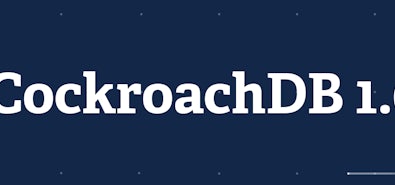
Today we released our latest version, CockroachDB 21.2. Our customers turn to CockroachDB for a highly scalable and resilient relational database — but they also value a familiar and comfortable developer experience, simple integrations with their preferred stack, and easy operations. In CockroachDB 21.2, we’ve extended our capabilities with these core principles in mind:
-
Integrate more seamlessly with event-driven data architectures using CockroachDB’s distributed Change Data Capture (CDC):
- Stream data updates to any https endpoint using a new webhook-style sink (in addition to the existing integrations with Kafka and cloud storage)
- Increase scale for your CDC capacity with higher throughput and improvements for large table sizes
- Get improved visibility and easier troubleshooting for CDC
-
Build against CockroachDB with a better developer experience, including:
- New SQL syntax including ON UPDATE and expression indexes
- Additional query performance data in the monitoring UI and the CLI, including index usage statistics, and an update that lets SQL Transactions and Statements data persist for multiple days
- New integrations with popular tools like Alembic and Sequelize
-
Operate more easily at massive scale with:
- Improvements to CockroachDB’s disaster preparedness and speed of recovery operations for large clusters
- Improvements to CockroachDB’s monitoring and visibility in the DB Console for large clusters
Our goal with CockroachDB has always been to make it easier for any developer to build data-intensive applications, and this release is another forward step in that journey. Many of these updates were in direct response to customer and community feedback, so we want to give a huge thanks to everyone who contributed their thoughts on using CockroachDB!
Read on to learn more, or head over to the Release Notes for a full list of what’s new. Meanwhile, are some highlights from CockroachDB 21.2.
Seamless integration with event-driven data architectures
Relational databases are often a key input to event-driven systems and feed data to data warehouses; however, they often require complex or costly mechanisms to integrate. We built CockroachDB’s distributed and native change data capture (CDC) to be different.
CDC in CockroachDB takes very few steps to set up and simplifies the number of components and amount of code needed to implement these workflows. CockroachDB’s CDC already integrates with Kafka and cloud storage—and in this release, we’ve added more integrations and have made it more scalable and easier to monitor:
- Stream data to more external tools with a new general-purpose, webhook-style sink. With this sink you can send changefeed messages to any https endpoint, letting you channel updates to more external services.
- Scale your CDC capacity more easily with higher throughput and improvements for large table sizes. Large-scale clusters and complex transactions can now send hundreds of thousands of changefeed messages per second through the pipeline, especially during traffic spikes.
- Get improved visibility and easier troubleshooting of changefeeds. New tools deliver expanded logging, and a new SQL command lets you view status information straight from the CLI.
Build with a better developer experience
This release puts more power into the hands of developers by making it simpler to build against CockroachDB and achieve optimal performance.
-
Customize CockroachDB to your application’s needs with new SQL syntax that gives you more schema design tools and lets you optimize for different workloads:
- ON UPDATE) - automatically update a column every time a row is updated, removing the need to implement this logic at the application layer.
- Expression indexes - apply expressions to entire columns and create an index on these expressions.
- More granular control over session settings - control session settings and defaults at the user, role, transaction, and database levels so you can tune functionality based on workload requirements.
-
Optimize SQL performance with more real-time and historical workload data in CockroachDB’s end-to-end monitoring experience:
- Identify workload performance trends over time with an update that allows SQL Statements and Transactions statistics to persist for multiple days in the DB Console.
- Retrieve query stats and diagnose issues straight from the SQL CLI with the addition of new metrics and internal tables, including query contention information and more table views.
- Improve write performance with new index usage stats. The index stats give you visibility into whether or not an index is being used, so you can drop unused indexes for optimal performance.
-
Integrate CockroachDB with your stack with new compatibility for popular tools. We’ve added support for Alembic, a schema migration tool for Python developers, and Sequelize, a Node.js ORM. This is in addition to existing support for popular ORMs and drivers for Javascript/Typescript, Python, Go, Java, Ruby, C, and C++.
Operate easily at massive scale
CockroachDB was architected to easily support massive scale. In this release, we focused on improving CockroachDB’s monitoring and visibility, disaster preparedness, and recovery operations for large scale users.
- Save time with faster backups at scale. Backups must be efficient for clusters that perform backups often, have a large number of nodes, or have a large amount of data per node. CockroachDB’s distributed backups are now faster at scale for these clusters thanks to improvements in the product and newly optimized management of backup files and their metadata.
- In the event of a disaster, get your cluster back online and running ASAP with new options to parallelize restore operations. This update, like the update for backups, improves speed of these operations for clusters with a large number of nodes or a large amount of data per node.
- More easily monitor database metrics for 100+ node clusters thanks to user experience improvements to the DB Console.
Get started with CockroachDB 21.2
These are just a sampling of the updates in CockroachDB 21.2. For a full list, head over to the Release Notes in docs. To try out these features yourself, you can get started for free on CockroachDB Dedicated, our cloud service. You can also try out many of these features on our newest offering, CockroachDB Serverless, now available in beta.
We’re also holding two live demos and Q&A sessions on Tuesday, December 7. Sign up for the North America session or the EMEA session. We hope to see you there.
Finally, we love feedback and would love to hear from you. Please join our Slack community and connect with us today!
Get started for free with CockroachDB 21.2!
Check out more helpful resources:


